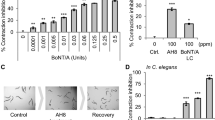Abstract
Synaptotagmin 1 (Syt1) is the Ca2+ sensor protein with an essential role in neurotransmitter release. Since the wrinkle formation is due to the excessive muscle fiber stimulation in the face, a helpful stratagem to diminish the wrinkle line intenseness is to weaken the innervating neuron activity through Syt1 inhibition which is one of the possible therapeutic strategies against wrinkles. Recently, experimental evidence showed that botox-like peptides, which are typically used as SNARE modulators, may inhibit Syt1. In this work, we applied molecular modeling to (1) characterize the structural framework and (2) define the atomistic information of the factors for the inhibition mechanism. The modeling identified the plausible binding cleft able to efficiently bind all botox-like peptides. The MD simulations revealed that all peptides induced significant Syt1 rigidity by binding in the cleft of the C2A–C2B interface. The consequence of this binding event is the suppression of the protein motion associated with conformational change of Syt1 from the closed form to the open form. On this basis, this finding may therefore be of subservience for the advancement of novel botox-like molecules for the therapeutic treatment of wrinkle, targeting and modulating the function of Syt1.










Similar content being viewed by others
References
Park T-Y, Shin M-J, Park S-D, Lee S-K (2013) Alleviation of abnormal synaptic neurotransmitter release by cell-permeable form of the truncated SNAP-25 upon transcutaneous delivery. Neurosci Lett 543:52–57. doi:10.1016/j.neulet.2013.02.055
Blanes-Mira C, Clemente J, Jodas G, Gil A, Fernández-Ballester G, Ponsati B, Gutierrez L, Pérez-Payá E, Ferrer-Montiel A (2002) A synthetic hexapeptide (Argireline) with antiwrinkle activity. Int J Cosmet Sci 24(5):303–310. doi:10.1046/j.1467-2494.2002.00153.x
Wang Y, Wang M, Xiao S, Pan P, Li P, Huo J (2013) The anti-wrinkle efficacy of argireline, a synthetic hexapeptide, in Chinese subjects. Am J Clin Dermatol 14(2):147–153. doi:10.1007/s40257-013-0009-9
Gorouhi F, Maibach HI (2017) Topical peptides and proteins for aging skin. In: Farage MA, Miller KW, Maibach HI (eds) Textbook of aging skin. Springer, Berlin, pp 1865–1896. doi:10.1007/978-3-662-47398-6_101
Baker RW, Hughson FM (2016) Chaperoning SNARE assembly and disassembly. Nat Rev Mol Cell Biol 17(8):465–479. doi:10.1038/nrm.2016.65
Fuson KL, Montes M, Robert JJ, Sutton RB (2007) Structure of human synaptotagmin 1 C2AB in the absence of Ca2+ reveals a novel domain association. Biochemistry 46(45):13041–13048. doi:10.1021/bi701651k
Jung CH, Yang YS, Kim J-S, Shin Y-K, Hwang JS, Son ED, Lee HH, Chung KM, Oh JM, Lee JH, Kweon D-H (2009) Inhibition of SNARE-driven neuroexocytosis by plant extracts. Biotechnol Lett 31(3):361–369. doi:10.1007/s10529-008-9878-z
Husein el Hadmed H, Castillo RF (2016) Cosmeceuticals: peptides, proteins, and growth factors. J Cosmet Dermatol 15(4):514–519. doi:10.1111/jocd.12229
Badhan R, Penny J (2006) In silico modelling of the interaction of flavonoids with human P-glycoprotein nucleotide-binding domain. Eur J Med Chem 41(3):285–295. doi:10.1016/j.ejmech.2005.11.012
Palestro PH, Gavernet L, Estiu GL, Bruno Blanch LE (2014) Docking applied to the prediction of the affinity of compounds to P-glycoprotein. Biomed Res Int 2014:10. doi:10.1155/2014/358425
Humphrey W, Dalke A, Schulten K (1996) VMD: visual molecular dynamics. J Mol Graph 14(1):33–38. doi:10.1016/0263-7855(96)00018-5
Roe DR, Cheatham TE (2013) PTRAJ and CPPTRAJ: software for processing and analysis of molecular dynamics trajectory data. J Chem Theory Comput 9(7):3084–3095. doi:10.1021/ct400341p
Venkateswarlu D (2014) Role of hydrophobic mutations on the binding affinity and stability of blood coagulation factor VIIIa: a computational molecular dynamics and free-energy analysis. Biochem Biophys Res Commun 450(1):735–740. doi:10.1016/j.bbrc.2014.06.043
Miller BR, McGee TD, Swails JM, Homeyer N, Gohlke H, Roitberg AE (2012) MMPBSA.py: an efficient program for end-state free energy calculations. J Chem Theory Comput 8(9):3314–3321. doi:10.1021/ct300418h
Wolber G, Langer T (2005) LigandScout: 3-D pharmacophores derived from protein-bound ligands and their use as virtual screening filters. J Chem Inf Model 45(1):160–169. doi:10.1021/ci049885e
Lazaridis T, Karplus M (1999) Discrimination of the native from misfolded protein models with an energy function including implicit solvation 1. J Mol Biol 288(3):477–487. doi:10.1006/jmbi.1999.2685
Zhang C, Feng L-J, Huang Y, Wu D, Li Z, Zhou Q, Wu Y, Luo H-B (2017) Discovery of novel phosphodiesterase-2A inhibitors by structure-based virtual screening, structural optimization, and bioassay. J Chem Inf Model 57(2):355–364. doi:10.1021/acs.jcim.6b00551
Yadav S, Pandey SK, Singh VK, Goel Y, Kumar A, Singh SM (2017) Molecular docking studies of 3-bromopyruvate and its derivatives to metabolic regulatory enzymes: implication in designing of novel anticancer therapeutic strategies. PLoS ONE 12(5):e0176403. doi:10.1371/journal.pone.0176403
Oh HI, Hoff JE, Armstrong GS, Haff LA (1980) Hydrophobic interaction in tannin-protein complexes. J Agric Food Chem 28(2):394–398. doi:10.1021/jf60228a020
Zhang W, Laursen RA (1998) Structure-function relationships in a type I antifreeze polypeptide: the role of threonine methyl and hydroxyl groups in antifreeze activity. J Biol Chem 273(52):34806–34812. doi:10.1074/jbc.273.52.34806
Khare SD, Ding F, Gwanmesia KN, Dokholyan NV (2005) Molecular origin of polyglutamine aggregation in neurodegenerative diseases. PLoS Comput Biol 1(3):e30. doi:10.1371/journal.pcbi.0010030
Gellman SH (1991) On the role of methionine residues in the sequence-independent recognition of nonpolar protein surfaces. Biochemistry 30(27):6633–6636. doi:10.1021/bi00241a001
Acknowledgements
The authors would like to thank Inte:Ligand Software-Entwicklungs und Consulting GmbH for providing an academic free license for LigandScout 4.1.
Author information
Authors and Affiliations
Corresponding authors
Ethics declarations
Conflict of interest
The authors have no conflict of interest to declare.
Rights and permissions
About this article
Cite this article
Wongrattanakamon, P., Nimmanpipug, P., Sirithunyalug, B. et al. Molecular modeling elucidates the cellular mechanism of synaptotagmin-SNARE inhibition: a novel plausible route to anti-wrinkle activity of botox-like cosmetic active molecules. Mol Cell Biochem 442, 97–109 (2018). https://doi.org/10.1007/s11010-017-3196-5
Received:
Accepted:
Published:
Issue Date:
DOI: https://doi.org/10.1007/s11010-017-3196-5




